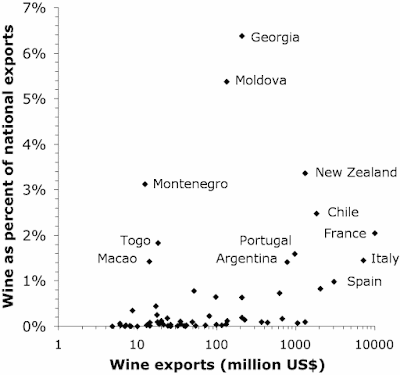A couple of weeks ago, I discussed the need for wine-makers to start thinking laterally, about what else they could be doing with their grapes, in the face of declining wine sales (The wine industry needs to say: “Cheese”). We cannot expect the commercial world to stand still, and so we must chase a moving target, by diversifying.
The basic point, here. is that relying on one product is a commercial risk. However, this same principle applies at much broader scales, as well. The one I will look at here is the national scale: How much do various wine-producing countries rely on wine for earning export dollars?
The data I will use come from the UN Comtrade International Trade Statistics Database, via the AAWE Facebook page (Leading wine exporting countries: value and share of wine exports in 2020).
For each country, we have data for 2020 on the amount of wine exports (in dollars) and the percentage that this constitutes of the total national exports across all products (in dollars). This will tell us how many of their “eggs” each country is metaphorically putting into the wine basket.
These data are shown in the graph, with each point representing a single country (or commercial region), located horizontally based on export amount (on a log scale) and vertically based on the reliance on wine alone.
For most countries, wine makes up less than 0.1% of national income from export dollars, irrespective of how much wine they export (from 5 million to 2,000 million dollars’ worth). However, 12 countries are labeled in the graph, each having wine make up more than 1%. There are a number of countries labeled here that you might not expect, such as Moldova, Montenegro, Togo and Macao (a part of China).
However, Georgia should definitely be on your mind, being one of the suggested birthplaces of wine-making. Indeed, I have written an entire blog post about the situation there (Current wine production at the birth-place of wine). Needless to say, things are not looking good just at the moment, given current events in nearby Ukraine (Georgian wine takes a pounding as Russia invades Ukraine). The increasingly dire situation arises, at least in part, because of the extent to which Georgia relies in wine export dollars, but mostly because their main export markets are actually both Russia and the Ukraine. By the way, the export percentage may have increased recently, because, according to the Annual Database of Global Wine Markets, the average for 2006—2016 was 3.6% (minimum 2.3%, maximum 6.3%).*
Moldova is much smaller than Georgia, but it is actually the Ukraine’s south-western neighbor; and so it has every reason to be concerned about current events. Interestingly, even though the country has a long tradition of wine-making, apparently most of the country’s wine production is made specifically for export (Wikipedia). Indeed, according to the Annual Database, the average exports as a % of wine production volume for 2006—2016 was 77% (no-one else comes even close to this!). Russia is the fourth largest export destination, by value. As an aside, Moldova is home to the largest wine cellar in the world, stretching for 200 km and with 2 million bottles of wine (This massive underground city is filled with wine).
As for Montenegrin wine, 1 million of the 13 million bottles exported apparently goes to Russia; so we are getting a familiar story here. At least the same cannot be said for Togo, where wine exports have literally boomed since 2016, with most of it going to nearby African countries. Lastly, Macao acts as re-export location within China, of course.
The other seven labeled countries are among the “usual suspects”, given that they include the world’s biggest wine-making regions, and are therefore the biggest exporters. However, note that Spain does not rely on dollars from wine exports to anywhere near the same extent as does New Zealand, the latter being 3.5 times greater. However, wine is still only the fifth biggest New Zealand export product, with “Dairy, eggs, honey” making up 29% of the dollars, and “Meat” (mostly sheep) being 14%. [In Spain, beverages are not even in the top 10.]
Note, finally, that Australia, the USA and Germany are all big wine exporters, but wine is <1% of their export income (although Australia is quite close to 1%). This is because these are all big manufacturing countries, resulting in exports; and the USA and Australia also have a large amount of natural resources for export (being large countries, geographically). So, wine is big, but quite small in the bigger scheme of things.
Anyway, most wine-making countries do not rely overly much on wine exports for their foreign income, but instead have a more balanced portfolio. However, the real crunch comes with over-reliance on a small number of export markets, as both the Georgians and Australians have recently found out, to their current cost. We will look at this in the next post.
* The American Association of Wine Economists (AAWE) will be holding their 2022 conference in Tbilisi, Georgia, August 24 – 28.




No comments:
Post a Comment